

| The silent disappearance of the Wall (and Brown) from Nottinghamshire | ||
| .... |
| Sometimes you don't
realise that you have missed something until its gone,
but its an apt phrase when referring to the Wall Brown, as this was once a common butterfly and now
on the verge of being lost as a breeding species. Today this delightful butterfly often has its name shortened, with the 'Brown' being dropped for some inexplicable reason, as Wall Brown is certainly a much more delightful sounding name than just 'Wall'. The original name was actually spot on and very descriptive, because this butterfly was common and widespread in Nottinghamshire's urban areas 30 or so years ago. It was never fussy about habitat and could be found relatively easily, anywhere that had not been developed or tidied up, even in the centre of Nottingham. |
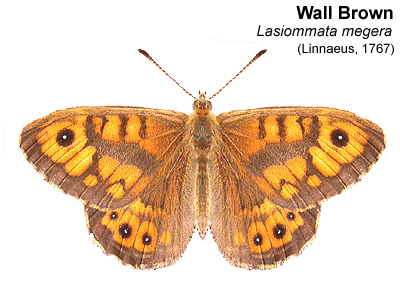 |
|
| ............... | ||
| A
butterfly in decline In the early 1980's, fellow butterfly enthusiast Gary Wilson and myself used to breed the Wall Brown (Lasiommata megera) and Speckled Wood in captivity for fun, before going on to concentrate on some of the rarer butterflies. To be honest, back then, the Wall Brown population of suburban Nottingham never needed augmenting by the release of captive stock, but it was impossible then to see how the fortunes of the two species would change so dramatically within the space of 20 or 30 years. Any sparsely vegetated strip of wasteland (or brownfield site as its known today) would hold this butterfly and we regularly saw females egg-laying on coarse grasses growing against buildings. Back then, you could hardly find a Speckled Wood in Nottinghamshire, yet the range of the Speckled Wood has expanded beyond belief since. Nowdays, it graces most gardens and open spaces throughout Nottinghamshire at some time during the year, and it is certainly a long way from being confined to woodland rides and glades it once was. |
||
| ............... |
| Fig 1: Total reported records and sites for the Wall Brown in Nottinghamshire between 1995 and 2017 | ||||||||||||||||||||||||
| ............... | ||||||||||||||||||||||||
| 1995 | 1996 | 1997 | 1998 | 1999 | 2000 | 2001 | 2002 | 2003 | 2004 | 2005 | 2006 | 2007 | 2008 | 2009 | 2010 | 2011 | 2012 | 2013 | 2014 | 2015 | 2016 | 2017 | ||
| Records | 100 | 102 | 111 | 106 | 159 | 67 | 33 | 37 | 31 | 28 | 32 | 10 | 4 | 6 | 10 | 17 | 18 | 1 | 0 | 3 | 1 | 1 | 0 | |
| Sites | 37 | 47 | 52 | 63 | 80 | 28 | 18 | 20 | 18 | 21 | 25 | 6 | 4 | 4 | 3 | 16 | 18 | 1 | 0 | 3 | 1 | 1 | 0 | |
| .... |
| The fortunes of the Wall
Brown have gone in the opposing direction and suddenly
too. As its range diminishes, the butterfly's overall UK
decline has been variously estimated to be in the region
of 65%, but virtually all the 1km grid squares we use in
our distribution maps (and in which Wall Brown has
occurred since 1995) show declines of 100%. Today, the
Wall Brown has nationally contracted its range towards
coastal areas and is on the point of extinction as a
breeding butterfly in Nottinghamshire, with just six
records from six different sites since 2012 and no
records reported to the county recorder in either 2013 or
2017. To the statistician, the Wall Brown's decline in Nottinghamshire makes interesting viewing or reading, as the number of sites and records each year since 1995 show that the decline consists of three clear stages of troughs and peaks, with peaks interestingly occurring every six years in 1999, 2005 and 2011 and each being smaller than the preceding one. |
| .... |
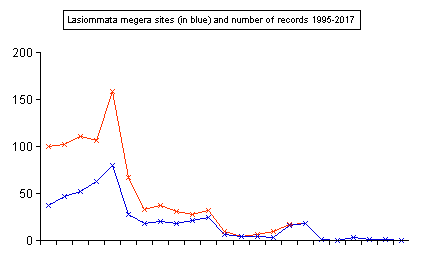 |
In what order the
declines and troughs commenced in we can't tell, as the
data only goes back to 1995, but it is probably safe to
assume that these population swings have been going on
for decades. Historical notes Its certainly worth looking at the historical account of the Wall Brown written by J.W. Carr in his 1916 publication 'The Invertebrate Fauna of Nottinghamshire': published by J.& H. Bell Ltd of Nottingham. Carr describes the Wall Brown as 'another decreasing species', which may seem surprising to those of us who can remember how common this butterfly was in the 1970's and 80's and who likewise presume that all butterflies were in abundant supply a century or more ago. |
| ..... |
| When Carr wrote his
summary, one statement refers to the Wall Brown being
much commoner a number of decades previously, i.e. a
statement that could easily refer to the butterfly's
current status. Carr described it as 'occasional at
Southwell 20 or 30 years ago, also at Ollerton (W.
Becher, 1900) and plentiful at Cork Hill Farm near
Southwell in the 1870's, but not seen since'. Wall Brown was a scarce butterfly in Nottinghamshire over a century ago, scarce enough for Carr to list most of the county's records individually, reporting that it was 'fairly common some seasons in the Mansfield district, taken in June and August 1896 (Daws). One specimen taken at Clipston near Plumtree 1893 (Leivers). One near Cotgrave (Wallis). Shireoaks 1899 (Houghton). Seen by Mr Leivers and myself flying commonly in the lanes about Wigsley snd Thorney on two dates in August 1900. One at Widmerpool August 1913 (Saunt) and one at Kingston-upon-Soar in August 1914 (Thornely)'. |
| ..... |
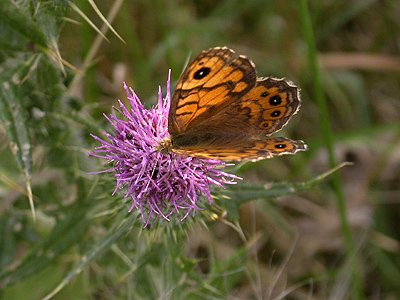 |
So sometime between the
early 1900's and the 1980's, the Wall Brown population
(and presumably its local range) increased for it to
become widespread and a regular sight. While numbers were
rarely any more than one's or two's at any site, it was
still a common butterfly and looking back with hindsight,
was considerably taken for granted as a species that was
always going to be there. Looking through our own records, we have not recorded a Wall Brown anywhere in Nottinghamshire since 2006, just a year after the last small build-up of numbers in 2005. But at Eakring, it was three years earlier that the sudden decline in numbers had really begun to become obvious. Reading our notes for 2003, we summarised at the time that 'the Wall Brown was increasing in numbers on previous years (1998-2002), but seemed to reach a halt in 2003 despite relatively high numbers'. |
|
| ..... | ||
| We felt sure that the Wall Brown's decline could not be completely down to a change in climatic conditions, as it has disappeared so quickly. The suddeness of the decline, based on our small sample of records coming from just the Eakring area, meant that any particular reason was always really going to be theoretic, but in many ways the Wall Brown's disappearance has been identical to the plight of another childhood favourite - the Garden Tiger moth. |
| ..... |
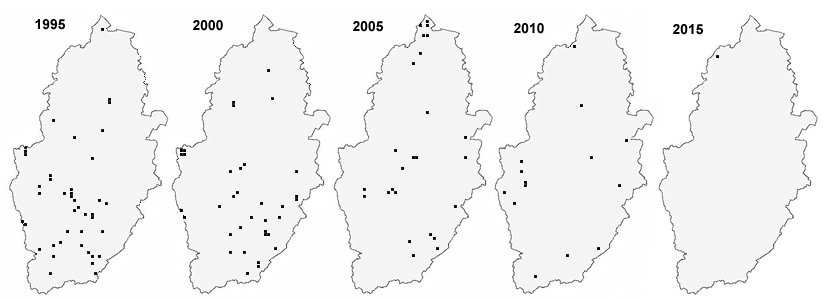 |
| ..... |
| The above series of maps
depict the Wall Brown's decline in Nottinghamshire over
the twenty year period 1995 to 2015. There seems to have
been little discernable pattern to the butterfly's
departure from the county either. There was just a single record in 2016 and when asked, we were told that none had been reported to the county recorder in 2017. The maps for 1995 and 2000 are generally similar, although there is a lack of records from the south-west corner of the county around Nottingham, running north through Mansfield and up as far as Worksop by 2000. Five years later in 2005 and the decline had become apparent. There was a cluster of new sites in the Misson area and still a thin scattering of records running down through central areas of the county, but most other records were from sites east of the River Trent. 2010 saw even further range retraction away from central Nottinghamshire. There were records from the Kirkby-in Ashfield, Newstead and Annesley areas and still a few sites reporting Wall Brown along the Trent Valley. 2011 marked the last of the peaks in the butterfly's numbers - albeit a very small peak. What was interesting was the high percentage of records from gardens compared to other years. 15 sites from a total of 18 came from gardens in the Meadows, Rise Park, Bramcote, Daybrook, West Bridgford, Beeston, Chilwell and Forest Fields. All these are urban or suburban areas of Nottingham, yet there had only been a a handful of records from urbanised ares of the City since the late 1990's. |
| ..... |
| The Wall Brown -
a permanent decline? The sudden urban boom in Wall Brown numbers ended abruptly and there have been just six Nottinghamshire records since 2012 and the county's last record is currently from Cropwell Bishop in 2016. So what has happened? In 1999, numbers were at their most recent highest in Nottinghamshire and Wall Browns were reported from a total of 80 sites. This in itself had represented a huge increase on just 37 sites four years earlier in 1995. Yet just four year later, the number of sites dropped to just 18, which is half of what it had been in 1995. Thats certainly some fluctuation within the numbers of any population. Since 2005, the Wall Brown has been recorded from a total of 65 different sites, with few sites in Nottinghamshire reporting it annually for any number of years. |
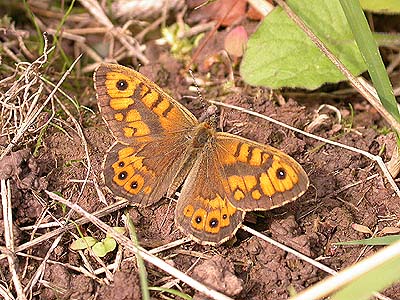 |
|
| .... | ||
| In fact, the butterfly seems to have had a rather transient existance, rarely being recorded from a single site for anything longer than two or three years. A general tidying up of our towns and cities, the over use of herbicides and the development brownfield sites, have not been condusive to the needs of the Wall Brown and neither has the weather. Since 2005, the increased regularity of extremely wet months with over 100mm (shown in the graph below as black vertical lines) of rain during the breeding season, may not have helped. The Wall Brown's three post-1995 peaks in 1999, 2005 and 2011, all came after several drier Summers. | ||
| .... |
| The site of the former
Calverton Colliery and the neighbouring woodland of
Watchwood, were the last sites in Nottinghamshire where
it last occurred with any regularity, but the Wall Brown
has not been seen there since 2009. Other regular sites
and the years when it was last seen include Colwick
Country Park in 2000, Bingham Linear Walk in 2006 and
Misson in 2012. Declines and increases in many of our native butterfly populations are nothing new and their populations are ever-changing and very likely to change in the future no matter how much we try to help them. The Comma began an enormous expansion of its UK range back in the 1940's, after being confined to areas near the Welsh border and how other species such as the Speckled Wood, Ringlet, Gatekeeper, Brown Argus, Dingy Skipper and Essex Skipper, have all increased their ranges substantially. |
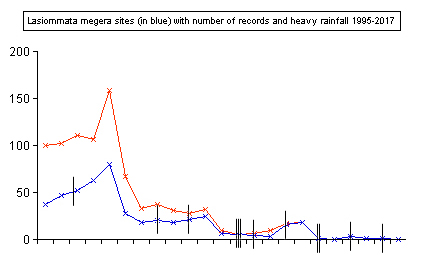 |
|
| .... | ||
| These range
expansions have steadily taken place over a number of
years and in many cases are probably in direct response
to the changes our climate is undergoing and which has
suited these butterflies in particular. The Wall Brown
represents a classic example of how our common insects
can suddenly slip away, virtually unnoticed and without
warning. Perhaps more importantly, we should be aware
that all our insects are worthy of care and protection,
no matter how common a distribution map indicates they
are and that conservation bodies and organisations,
should not neccessarily create areas of habitat to save a
few species at the risk of others. Common insects are often largely ignored by recorders, who can sometimes have a tendency to send in records that only they regard as being important. We were recently asked by someone, about who they should send their rare invertebrate records to. We replied that they should send all their records to the relevant county recorder and to send everything, not to filter out what they think may be interesting or known to be rare, because we often know more about the rare species than we do the common ones. Its amazing how very common species often get neglected, as every single record is important towards developing a much clearer picture of our fauna. |